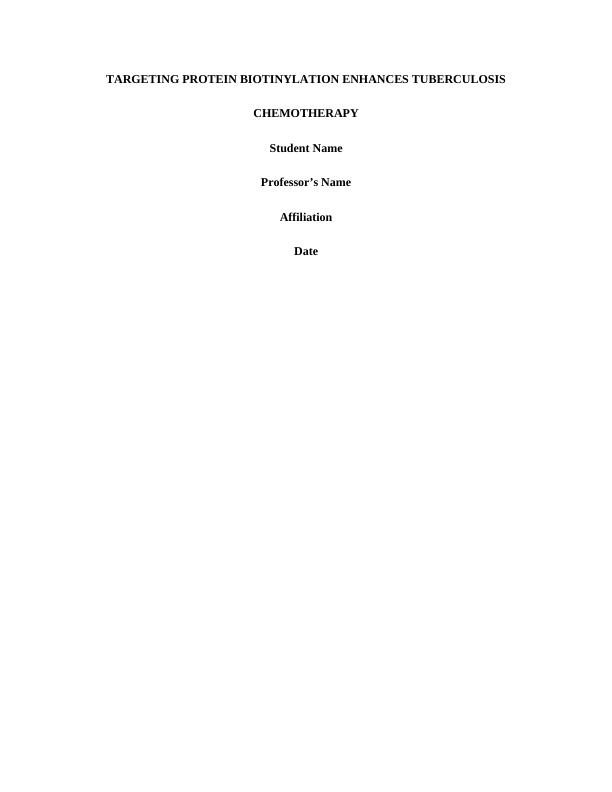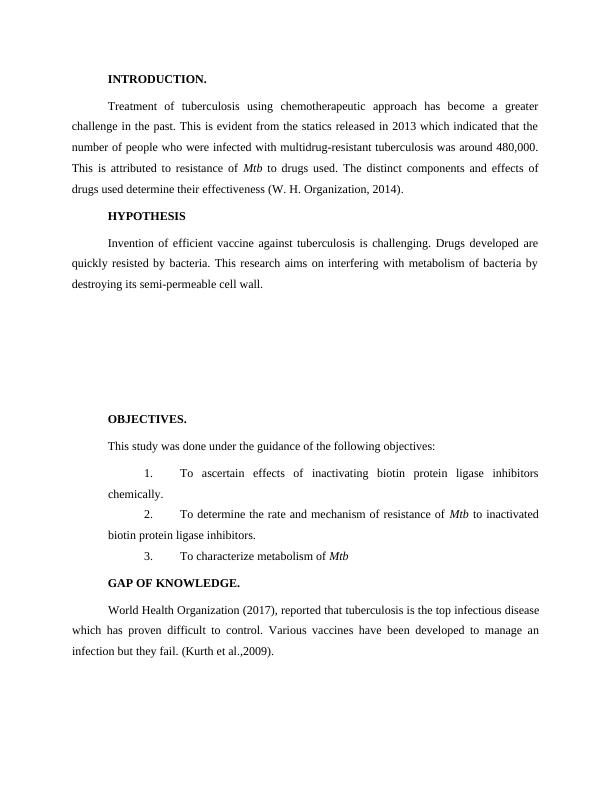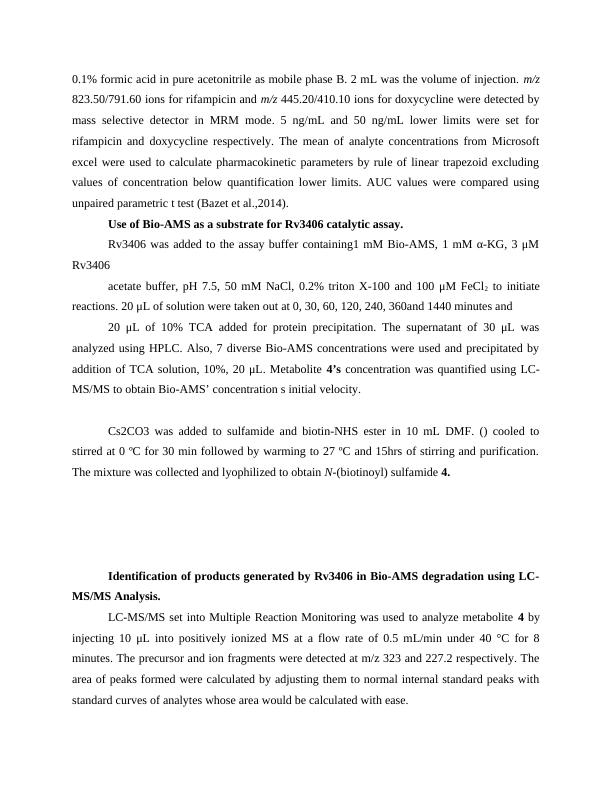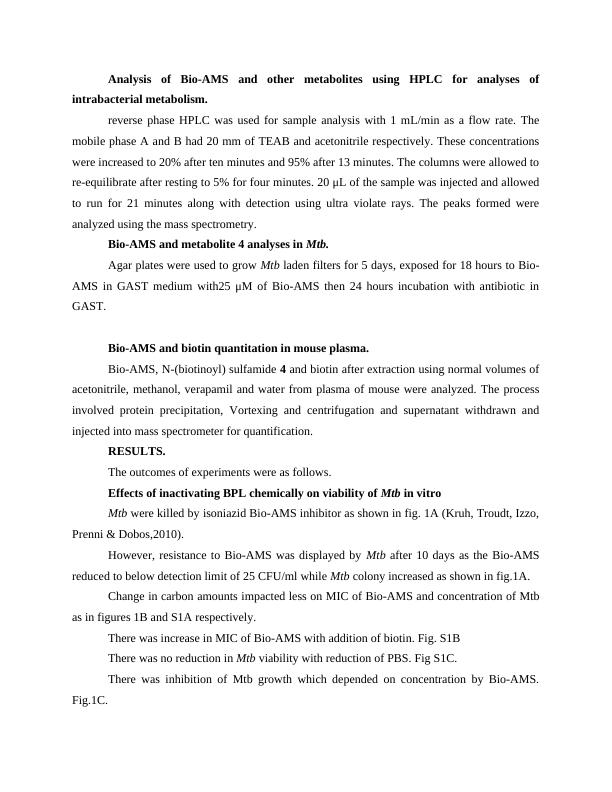Targeting Protein Biotinylation Enhances Tuberculosis Chemotherapy
This research article discusses the targeting of protein biotinylation as a potential strategy to enhance tuberculosis chemotherapy.
23 Pages4411 Words456 Views
Added on 2023-06-04
About This Document
This research focuses on use of biotinylation in fighting against the Mtb. The study aims to ascertain effects of inactivating biotin protein ligase inhibitors chemically, determine the rate and mechanism of resistance of Mtb to inactivated biotin protein ligase inhibitors and characterize metabolism of Mtb.
Targeting Protein Biotinylation Enhances Tuberculosis Chemotherapy
This research article discusses the targeting of protein biotinylation as a potential strategy to enhance tuberculosis chemotherapy.
Added on 2023-06-04
ShareRelated Documents
TARGETING PROTEIN BIOTINYLATION ENHANCES TUBERCULOSIS
CHEMOTHERAPY
Student Name
Professor’s Name
Affiliation
Date
CHEMOTHERAPY
Student Name
Professor’s Name
Affiliation
Date

INTRODUCTION.
Treatment of tuberculosis using chemotherapeutic approach has become a greater
challenge in the past. This is evident from the statics released in 2013 which indicated that the
number of people who were infected with multidrug-resistant tuberculosis was around 480,000.
This is attributed to resistance of Mtb to drugs used. The distinct components and effects of
drugs used determine their effectiveness (W. H. Organization, 2014).
HYPOTHESIS
Invention of efficient vaccine against tuberculosis is challenging. Drugs developed are
quickly resisted by bacteria. This research aims on interfering with metabolism of bacteria by
destroying its semi-permeable cell wall.
OBJECTIVES.
This study was done under the guidance of the following objectives:
1. To ascertain effects of inactivating biotin protein ligase inhibitors
chemically.
2. To determine the rate and mechanism of resistance of Mtb to inactivated
biotin protein ligase inhibitors.
3. To characterize metabolism of Mtb
GAP OF KNOWLEDGE.
World Health Organization (2017), reported that tuberculosis is the top infectious disease
which has proven difficult to control. Various vaccines have been developed to manage an
infection but they fail. (Kurth et al.,2009).
Treatment of tuberculosis using chemotherapeutic approach has become a greater
challenge in the past. This is evident from the statics released in 2013 which indicated that the
number of people who were infected with multidrug-resistant tuberculosis was around 480,000.
This is attributed to resistance of Mtb to drugs used. The distinct components and effects of
drugs used determine their effectiveness (W. H. Organization, 2014).
HYPOTHESIS
Invention of efficient vaccine against tuberculosis is challenging. Drugs developed are
quickly resisted by bacteria. This research aims on interfering with metabolism of bacteria by
destroying its semi-permeable cell wall.
OBJECTIVES.
This study was done under the guidance of the following objectives:
1. To ascertain effects of inactivating biotin protein ligase inhibitors
chemically.
2. To determine the rate and mechanism of resistance of Mtb to inactivated
biotin protein ligase inhibitors.
3. To characterize metabolism of Mtb
GAP OF KNOWLEDGE.
World Health Organization (2017), reported that tuberculosis is the top infectious disease
which has proven difficult to control. Various vaccines have been developed to manage an
infection but they fail. (Kurth et al.,2009).

TB vaccine community in 2012 came up with a Blueprint for developing vaccine for TB.
Among the attempts was on the use of cytomegalovirus (CMV) vector. CMV has an ability to
slow down the rate of replication of Mtb but cannot stop its trasmission (Lyonnete et al.,2014).
Another attempt was on the use of mRNA vaccine. This vaccine was used to make any
symptoms of the tuberculosis especially in latent type of tuberculosis to be expressed so that it
can be treated. This vaccine presented a challenge in the way that it could be administered into
the body (Nikonenko, Protopopova, Samala, Einck & Nacy,2007). The use of intravenous route
was impossible since it could be integrated into non-functional vector (Galvão et al.,2014).
Due to this existing gap, this research focuses on use of biotinylation in fighting against
the Mtb. (Moliva, Turner & Torrelles,2015).
MATERIALS AND METHODS.
To achieve the objectives of this research, the following materials were required and the
following methods were followed (Srivastava & Gumbo,2011).:
Method: Studies of Rifampicin-doxycycline interaction.
-Four groups of female mice belonging to 4 CD-1, age: 4-6 weeks, 20-22 g weight,
Rifampicin, Sucrose solution., Water-bath sonicator, Centrifuge, LC/MS-MS
Method: Rifampicin and doxycycline quantitation in mouse plasma.
-Water, Acetonitrile, Ascorbic acid, Methanol, Verapamil, Vertexing machine, Agilent
and Mass selective detector.
Method: Use of Bio-AMS as a substrate for Rv3406 catalytic assay.
-Centrifuging, HPLC
Method: Identification of products generated by Rv3406 in Bio-AMS degradation using
LC-MS/MS Analysis.
-LC-MS/MS, formic acid.
Method: Analysis of Bio-AMS and other metabolites using HPLC for analyses of
intrabacterial metabolism.
- HPLC, mass spectrometry.
Among the attempts was on the use of cytomegalovirus (CMV) vector. CMV has an ability to
slow down the rate of replication of Mtb but cannot stop its trasmission (Lyonnete et al.,2014).
Another attempt was on the use of mRNA vaccine. This vaccine was used to make any
symptoms of the tuberculosis especially in latent type of tuberculosis to be expressed so that it
can be treated. This vaccine presented a challenge in the way that it could be administered into
the body (Nikonenko, Protopopova, Samala, Einck & Nacy,2007). The use of intravenous route
was impossible since it could be integrated into non-functional vector (Galvão et al.,2014).
Due to this existing gap, this research focuses on use of biotinylation in fighting against
the Mtb. (Moliva, Turner & Torrelles,2015).
MATERIALS AND METHODS.
To achieve the objectives of this research, the following materials were required and the
following methods were followed (Srivastava & Gumbo,2011).:
Method: Studies of Rifampicin-doxycycline interaction.
-Four groups of female mice belonging to 4 CD-1, age: 4-6 weeks, 20-22 g weight,
Rifampicin, Sucrose solution., Water-bath sonicator, Centrifuge, LC/MS-MS
Method: Rifampicin and doxycycline quantitation in mouse plasma.
-Water, Acetonitrile, Ascorbic acid, Methanol, Verapamil, Vertexing machine, Agilent
and Mass selective detector.
Method: Use of Bio-AMS as a substrate for Rv3406 catalytic assay.
-Centrifuging, HPLC
Method: Identification of products generated by Rv3406 in Bio-AMS degradation using
LC-MS/MS Analysis.
-LC-MS/MS, formic acid.
Method: Analysis of Bio-AMS and other metabolites using HPLC for analyses of
intrabacterial metabolism.
- HPLC, mass spectrometry.

Method: Bio-AMS and metabolite 4 analyses in Mtb.
- Agar plates.
Method: Bio-AMS and biotin quantitation in mouse plasma.
- Acetonitrile, water, methanol, verapamil, mass spectrometer, LC/MS.
EXPLANATIONS AND DESCRIPTIONS.
This section gives a detail on the procedures that were followed in carrying out the
experiments using the above listed methods and their respective materials (Srivastava &
Gumbo,2011).
Studies of Rifampicin-doxycycline interaction.
Selected four female mice were administered orally with 2000 ppm of rifampicin.
In preparing the rifampicin administered, 40% of sucrose was added in it and digested for
ten minutes in water-bath sonicator and finally it was subjected to probe sonication for a period
of three minutes.
40-50 mm were then collected from the veins of tails of the mice in both groups.
Different mice groups were given different doses.10 mg/kg of rifampicin was given to
group one as a single dose. Doxycycline with chow was given consecutively for 7 days and a
single of 10mg/kg of rifampicin was given on 7th day. For seven consecutive days, group three
was given 10 mg/kg of rifampicin while group four was given for seven consecutive days 10
mg/kg of rifampicin and doxycycline having chow. Blood sample collection was done on
seventh day in pre-dose,5 min, 30 min, 1 h, 3 h,5 h and 8 h after dose using heparin-made tubes.
Plasma from blood were recovered by centrifugation and quantified for rifampicin and
doxycycline using LC/MS-MS.
Rifampicin and doxycycline quantitation in mouse plasma.
To obtain the analytes for analysis,20 microliters of mouse plasma was diluted using 180
milliliters of methanol and acetonitrile having 20 ng/rifampicin in the ratio of 1:1, 5 microliters
of 75 mg/mL ascorbic acid and 180 milliliters of methanol mixed with acetonitrile having
20ng/mL rifampicin and 10 ng/mL of verapamil to dissolve doxycycline. Vortexing and
centrifugation was done to the mixture. 200 microliters of supernatant were retrieved and
analyzed using LC/MS-MS which had 0.1% formic acid in pure water as mobile phase A and
- Agar plates.
Method: Bio-AMS and biotin quantitation in mouse plasma.
- Acetonitrile, water, methanol, verapamil, mass spectrometer, LC/MS.
EXPLANATIONS AND DESCRIPTIONS.
This section gives a detail on the procedures that were followed in carrying out the
experiments using the above listed methods and their respective materials (Srivastava &
Gumbo,2011).
Studies of Rifampicin-doxycycline interaction.
Selected four female mice were administered orally with 2000 ppm of rifampicin.
In preparing the rifampicin administered, 40% of sucrose was added in it and digested for
ten minutes in water-bath sonicator and finally it was subjected to probe sonication for a period
of three minutes.
40-50 mm were then collected from the veins of tails of the mice in both groups.
Different mice groups were given different doses.10 mg/kg of rifampicin was given to
group one as a single dose. Doxycycline with chow was given consecutively for 7 days and a
single of 10mg/kg of rifampicin was given on 7th day. For seven consecutive days, group three
was given 10 mg/kg of rifampicin while group four was given for seven consecutive days 10
mg/kg of rifampicin and doxycycline having chow. Blood sample collection was done on
seventh day in pre-dose,5 min, 30 min, 1 h, 3 h,5 h and 8 h after dose using heparin-made tubes.
Plasma from blood were recovered by centrifugation and quantified for rifampicin and
doxycycline using LC/MS-MS.
Rifampicin and doxycycline quantitation in mouse plasma.
To obtain the analytes for analysis,20 microliters of mouse plasma was diluted using 180
milliliters of methanol and acetonitrile having 20 ng/rifampicin in the ratio of 1:1, 5 microliters
of 75 mg/mL ascorbic acid and 180 milliliters of methanol mixed with acetonitrile having
20ng/mL rifampicin and 10 ng/mL of verapamil to dissolve doxycycline. Vortexing and
centrifugation was done to the mixture. 200 microliters of supernatant were retrieved and
analyzed using LC/MS-MS which had 0.1% formic acid in pure water as mobile phase A and

0.1% formic acid in pure acetonitrile as mobile phase B. 2 mL was the volume of injection. m/z
823.50/791.60 ions for rifampicin and m/z 445.20/410.10 ions for doxycycline were detected by
mass selective detector in MRM mode. 5 ng/mL and 50 ng/mL lower limits were set for
rifampicin and doxycycline respectively. The mean of analyte concentrations from Microsoft
excel were used to calculate pharmacokinetic parameters by rule of linear trapezoid excluding
values of concentration below quantification lower limits. AUC values were compared using
unpaired parametric t test (Bazet et al.,2014).
Use of Bio-AMS as a substrate for Rv3406 catalytic assay.
Rv3406 was added to the assay buffer containing1 mM Bio-AMS, 1 mM α-KG, 3 μM
Rv3406
acetate buffer, pH 7.5, 50 mM NaCl, 0.2% triton X-100 and 100 μM FeCl2 to initiate
reactions. 20 μL of solution were taken out at 0, 30, 60, 120, 240, 360and 1440 minutes and
20 μL of 10% TCA added for protein precipitation. The supernatant of 30 μL was
analyzed using HPLC. Also, 7 diverse Bio-AMS concentrations were used and precipitated by
addition of TCA solution, 10%, 20 μL. Metabolite 4’s concentration was quantified using LC-
MS/MS to obtain Bio-AMS’ concentration s initial velocity.
Cs2CO3 was added to sulfamide and biotin-NHS ester in 10 mL DMF. () cooled to
stirred at 0 ºC for 30 min followed by warming to 27 ºC and 15hrs of stirring and purification.
The mixture was collected and lyophilized to obtain N-(biotinoyl) sulfamide 4.
Identification of products generated by Rv3406 in Bio-AMS degradation using LC-
MS/MS Analysis.
LC-MS/MS set into Multiple Reaction Monitoring was used to analyze metabolite 4 by
injecting 10 μL into positively ionized MS at a flow rate of 0.5 mL/min under 40 °C for 8
minutes. The precursor and ion fragments were detected at m/z 323 and 227.2 respectively. The
area of peaks formed were calculated by adjusting them to normal internal standard peaks with
standard curves of analytes whose area would be calculated with ease.
823.50/791.60 ions for rifampicin and m/z 445.20/410.10 ions for doxycycline were detected by
mass selective detector in MRM mode. 5 ng/mL and 50 ng/mL lower limits were set for
rifampicin and doxycycline respectively. The mean of analyte concentrations from Microsoft
excel were used to calculate pharmacokinetic parameters by rule of linear trapezoid excluding
values of concentration below quantification lower limits. AUC values were compared using
unpaired parametric t test (Bazet et al.,2014).
Use of Bio-AMS as a substrate for Rv3406 catalytic assay.
Rv3406 was added to the assay buffer containing1 mM Bio-AMS, 1 mM α-KG, 3 μM
Rv3406
acetate buffer, pH 7.5, 50 mM NaCl, 0.2% triton X-100 and 100 μM FeCl2 to initiate
reactions. 20 μL of solution were taken out at 0, 30, 60, 120, 240, 360and 1440 minutes and
20 μL of 10% TCA added for protein precipitation. The supernatant of 30 μL was
analyzed using HPLC. Also, 7 diverse Bio-AMS concentrations were used and precipitated by
addition of TCA solution, 10%, 20 μL. Metabolite 4’s concentration was quantified using LC-
MS/MS to obtain Bio-AMS’ concentration s initial velocity.
Cs2CO3 was added to sulfamide and biotin-NHS ester in 10 mL DMF. () cooled to
stirred at 0 ºC for 30 min followed by warming to 27 ºC and 15hrs of stirring and purification.
The mixture was collected and lyophilized to obtain N-(biotinoyl) sulfamide 4.
Identification of products generated by Rv3406 in Bio-AMS degradation using LC-
MS/MS Analysis.
LC-MS/MS set into Multiple Reaction Monitoring was used to analyze metabolite 4 by
injecting 10 μL into positively ionized MS at a flow rate of 0.5 mL/min under 40 °C for 8
minutes. The precursor and ion fragments were detected at m/z 323 and 227.2 respectively. The
area of peaks formed were calculated by adjusting them to normal internal standard peaks with
standard curves of analytes whose area would be calculated with ease.

Analysis of Bio-AMS and other metabolites using HPLC for analyses of
intrabacterial metabolism.
reverse phase HPLC was used for sample analysis with 1 mL/min as a flow rate. The
mobile phase A and B had 20 mm of TEAB and acetonitrile respectively. These concentrations
were increased to 20% after ten minutes and 95% after 13 minutes. The columns were allowed to
re-equilibrate after resting to 5% for four minutes. 20 μL of the sample was injected and allowed
to run for 21 minutes along with detection using ultra violate rays. The peaks formed were
analyzed using the mass spectrometry.
Bio-AMS and metabolite 4 analyses in Mtb.
Agar plates were used to grow Mtb laden filters for 5 days, exposed for 18 hours to Bio-
AMS in GAST medium with25 μM of Bio-AMS then 24 hours incubation with antibiotic in
GAST.
Bio-AMS and biotin quantitation in mouse plasma.
Bio-AMS, N-(biotinoyl) sulfamide 4 and biotin after extraction using normal volumes of
acetonitrile, methanol, verapamil and water from plasma of mouse were analyzed. The process
involved protein precipitation, Vortexing and centrifugation and supernatant withdrawn and
injected into mass spectrometer for quantification.
RESULTS.
The outcomes of experiments were as follows.
Effects of inactivating BPL chemically on viability of Mtb in vitro
Mtb were killed by isoniazid Bio-AMS inhibitor as shown in fig. 1A (Kruh, Troudt, Izzo,
Prenni & Dobos,2010).
However, resistance to Bio-AMS was displayed by Mtb after 10 days as the Bio-AMS
reduced to below detection limit of 25 CFU/ml while Mtb colony increased as shown in fig.1A.
Change in carbon amounts impacted less on MIC of Bio-AMS and concentration of Mtb
as in figures 1B and S1A respectively.
There was increase in MIC of Bio-AMS with addition of biotin. Fig. S1B
There was no reduction in Mtb viability with reduction of PBS. Fig S1C.
There was inhibition of Mtb growth which depended on concentration by Bio-AMS.
Fig.1C.
intrabacterial metabolism.
reverse phase HPLC was used for sample analysis with 1 mL/min as a flow rate. The
mobile phase A and B had 20 mm of TEAB and acetonitrile respectively. These concentrations
were increased to 20% after ten minutes and 95% after 13 minutes. The columns were allowed to
re-equilibrate after resting to 5% for four minutes. 20 μL of the sample was injected and allowed
to run for 21 minutes along with detection using ultra violate rays. The peaks formed were
analyzed using the mass spectrometry.
Bio-AMS and metabolite 4 analyses in Mtb.
Agar plates were used to grow Mtb laden filters for 5 days, exposed for 18 hours to Bio-
AMS in GAST medium with25 μM of Bio-AMS then 24 hours incubation with antibiotic in
GAST.
Bio-AMS and biotin quantitation in mouse plasma.
Bio-AMS, N-(biotinoyl) sulfamide 4 and biotin after extraction using normal volumes of
acetonitrile, methanol, verapamil and water from plasma of mouse were analyzed. The process
involved protein precipitation, Vortexing and centrifugation and supernatant withdrawn and
injected into mass spectrometer for quantification.
RESULTS.
The outcomes of experiments were as follows.
Effects of inactivating BPL chemically on viability of Mtb in vitro
Mtb were killed by isoniazid Bio-AMS inhibitor as shown in fig. 1A (Kruh, Troudt, Izzo,
Prenni & Dobos,2010).
However, resistance to Bio-AMS was displayed by Mtb after 10 days as the Bio-AMS
reduced to below detection limit of 25 CFU/ml while Mtb colony increased as shown in fig.1A.
Change in carbon amounts impacted less on MIC of Bio-AMS and concentration of Mtb
as in figures 1B and S1A respectively.
There was increase in MIC of Bio-AMS with addition of biotin. Fig. S1B
There was no reduction in Mtb viability with reduction of PBS. Fig S1C.
There was inhibition of Mtb growth which depended on concentration by Bio-AMS.
Fig.1C.

End of preview
Want to access all the pages? Upload your documents or become a member.
